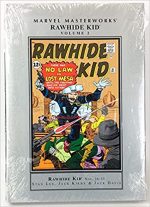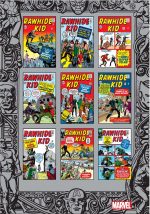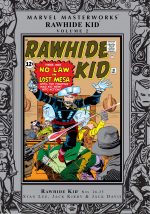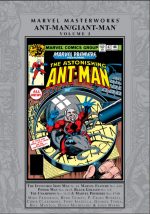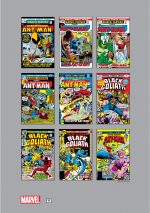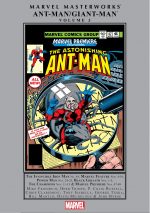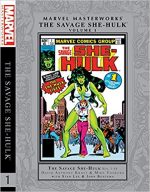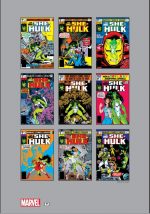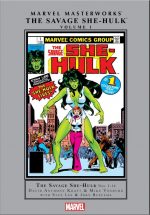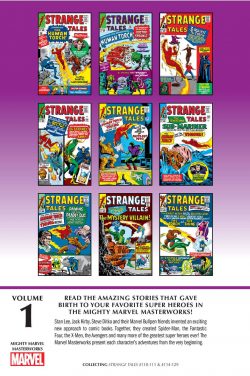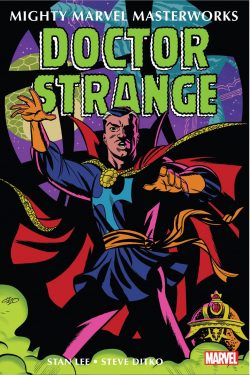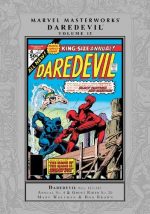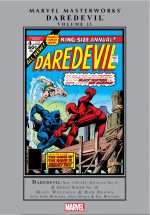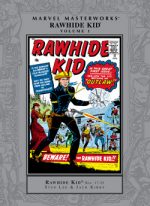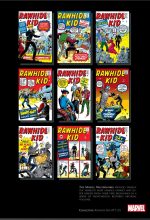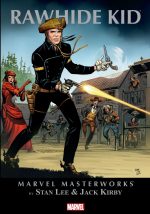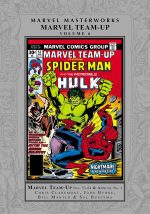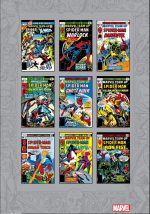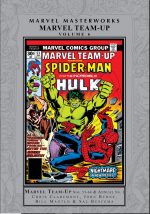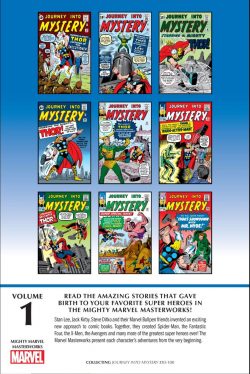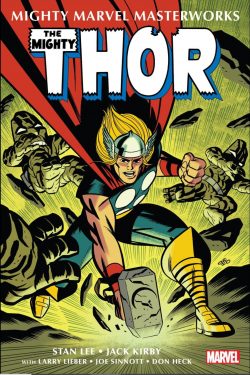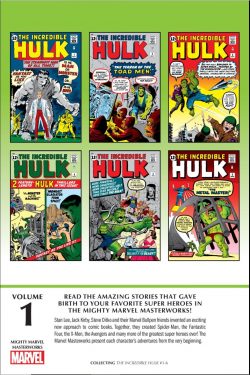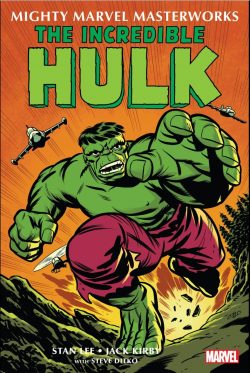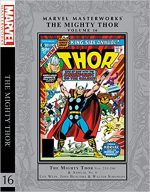
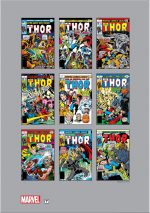
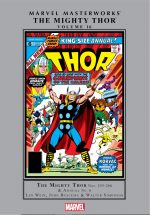
By Len Wein, Roger Stern, John Buscema, Walter Simonson, Tony DeZuñiga, Sal Buscema & various (MARVEL)
ISBN: 978-1-3029-0358-9 (HB/Digital edition)
Once upon a time, disabled physician Donald Blake took a vacation in Norway, only to stumble into an alien invasion. Trapped in a cave, he found an ancient walking stick which, when struck against the ground, turned him into the Norse God of Thunder! Within moments, he was defending the weak and smiting the wicked.
Months swiftly passed, with the Lord of Storms tackling rapacious extraterrestrials, Commie dictators, costumed crazies and cheap thugs, but these soon gave way to a vast kaleidoscope of fantastic worlds and incredible, mythic menaces, usually tackled with an ever-changing cast of stalwart immortal warriors at his side…
Whilst the ever-expanding Marvel Universe had grown ever-more interconnected as it matured through its first decade, with characters literally tripping over each other in New York City, the Asgardian heritage of Thor and the soaring imagination of Jack Kirby had most often drawn the Thunder God away from mortal realms into stunning, unique landscapes and scenarios.
However, by the time of this power-packed compendium, the King was long gone and in fact enacting his Second Coming – technically third, but definitely Second Return to the House of (mostly his) Ideas – and only echoes of his groundbreaking presence remained. John Buscema had visually made the Thunder God his own over the interceding years, whilst a succession of scripters had struggled with varying success to recapture the epic scope of Kirby’s vision and Stan Lee’s off-kilter but comfortingly compelling faux-Shakespearean verbiage…
Spanning January-December 1977, this power-packed compilation re-presents The Mighty Thor #255-266 and Annual #6, and leads with ‘Over the Rainbow Bridge’: an engaging Introduction intriguingly illustrated from involved illustrator and eventual redeemer of the Thor franchise – Walter Simonson.
The action opens behind the Kirby cover for Thor #255, as Len Wein & Tony DeZuñiga launch a new epic interstellar adventure in ‘Lo, the Quest Begins!’ Previously, embattled Asgard survived invasion only to learn their divine Liege Lord Odin had gone missing. Now, having exhausted every avenue of location available, Thor is compelled to search the galaxies, prompted by vague hints from all-knowing spirit Mimir of a distant destination – the Doomsday Star…
Boarding spacefaring dragonship Starjammer, Thor, Lady Sif, and Warriors Three Fandral, Hogun and Volstagg set (solar) sail, leaving a beleaguered Eternal Realm under the stewardship of Balder the Brave and his dark inamorata Karnilla the Norn Queen. However, before they even leave local space, the seekers encounter – and battle – malign aliens marooned ever since they initially fought the Storm Lord in his debut adventure…
A classic case of Marvel Misunderstanding occurs in #256 as the voyagers encounter an ancient and colossal colony ship populated by the last survivors of a civilisation that died from over-exploiting their environment. As the Asgardians are joined by Rigellian Recorder Memorax, the slowly-fading Levianons reveal how their poverty and resource-blighted existence has been further threatened by an invasive beast who takes the elderly like a ‘Lurker in the Dark!’ (Wein, John Buscema & DeZuñiga).
When the hideous Sporr also abducts recently wounded Sif, enraged Thor leads a savage counter-assault that sparks incomprehensible tragedy in concluding chapter ‘Death, Thou Shalt Die!’
Another mineral-based miscreant resurfaces in #258. ‘If the Stars be Made of Stone!’ sees the Starjammer attacked by space pirates inexplicably led by human super-villain – and early Thor foe – the Grey Gargoyle. The job is not one he wants, but as the unwilling captain conspires with the beaten-&-enslaved Asgardians for a chance to see again the Green Hills of Earth, their plot is exposed by fanatical second-in command Fee-Lon.
The brutal usurper is a truly ferocious brigand, but ultimately fights in vain to end the gods’ ‘Escape into Oblivion!’
Meanwhile in Asgard, Balder and Karnilla have been resisting an invasion helmed by arch-traitors Enchantress and Executioner. As Walter Simonson signs on beside Wein & DeZuñiga from #260, that subplot expands and intensifies even as ‘The Vicious and the Valiant’ sees the interstellar questors finally locate the Doomsday Star and falter before ‘The Wall Around the World!’ (inked by Ernie Chan).
The terrifying global construct is comprised of the power-drained husks of dead gods, but determinedly pushing on, the seekers discover Odin has been captured and slowly diminished by the energy-leeching Soul-Survivors whose civilisation subsists on stolen divine power. As they valiantly strive to save their sovereign, the Asgardians learn to their cost that ‘Even an Immortal Can Die!’ (#262, illustrated by Simonson & DeZuñiga).
Thankfully, ‘Holocaust and Homecoming!’ proves Odin is both wily and mighty as the heroes’ ferocious clash and inevitable victory results in a weary and wounded pantheon returning to Asgard to find it taken over by Loki and his cohort of treacherous allies.
With Odin in a coma – and ultimately abducted again – a covert civil war erupts between the returned champions and the city Loki has subverted. ‘Thou Shalt Have No Other Gods Before Me!’ sees a sinister scheme exposed, but not before Loki unleashes ultimate weapon The Destroyer against his step-brother in #265’s ‘When Falls the God of Thunder…!’ (inked by Joe Sinnott). As before, it’s not long before Loki loses control of his ultimate sanction…
Once again, everything hinges on the power and determination of Thor and his valiant resistance to chaos. In #266’s ‘…So Falls the Realm Eternal!’, Wein, Simonson & DeZuñiga show the Thunderer at his indomitable best, keeping Loki at bay and off kilter until the Warriors Three rescue and revive an extremely unhappy All-Father…
This saga presaged a change of focus that we’ll cover in the next volume but before then the epic entertainment concludes with ‘Thunder in the 31st Century!’ by Roger Stern, Sal Buscema & Klaus Janson from Thor Annual #6 (December 1977).
A riot of time-busting mayhem, it commences with Mighty Thor plucked from contemporary Manhattan: accidentally summoned to the time period of the original/future (time travel tenses suck!) Guardians of the Galaxy by a cyborg maniac named Korvac.
The legendary god-warrior briefly joins Vance Astro, Charlie 27, Yondu, Nikki, Martinex and Starhawk to bombastically battle super-powered aliens and thwart the sinister cyborg’s scheme to become master of the universe. At the conclusion, Thor returns to his own place and time, unaware how Korvac will reshape the destiny of reality itself in coming months…
To Be Continued…
Augmenting this volume is a blockbusting original art gallery, offering 21 pages of sketches, layouts, pencils and fully inked covers, splash and story-pages by Kirby & John Verpoorten, Buscema, DeZuñiga, Simonson, Joe Sinnott &Ernie Chan: a true treat for every art lover.
The tales gathered here may lack the sheer punch and verve of the early years but fans of ferocious Fights ‘n’ Tights fantasy will find this tome still stuffed with intrigue and action, magnificently rendered by artists who, whilst not possessing Kirby’s vaulting visionary passion, were every inch his equal in craft and dedication. In Thor’s anniversary year, this a definite and decidedly engaging must-read for all fans of the character and the genre.
© 2017 Marvel Characters, Inc. All rights reserved.

